by
User Not Found
| Mar 15, 2019
Andrew Kell, Assistant Principal, Marrickville Public School, Sydney, NSW
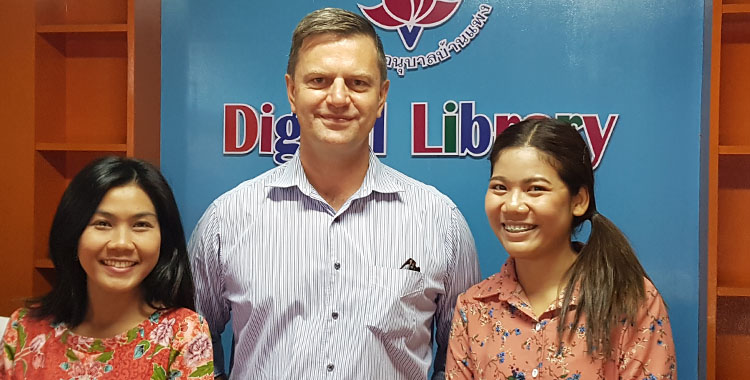
At Marrickville Public School, intercultural understanding has been a foundation principle for a long time. Our school plan goals of Achieve, Create, Inspire include a range of targets for authentic involvement with our multicultural community. We display school signage in English, Vietnamese, Greek, Chinese, Portuguese and Tongan, offer community language classes in Vietnamese and Greek for all students, embed a wide range of global celebrations in our calendar, and work with local elders to create a NAIDOC week that is recognised by the Department of Education and our local schools as a model of best practice.
Last year, our school became an ASEAN BRIDGE Partner with Khamthieng Anussorn School in Chiang Mai, Thailand. We called our partnership “Open The Door” with the goal of Quality Teaching through Narrative > Empathy > Intercultural Understanding. We wanted to encourage our students to share their stories with each other.
The arrival of Mr Poom Pananta in March 2018 was recognised in the staffroom, classrooms, the playground and the assembly hall. Teachers, parents and members of the P&C held a welcome lunch, students greeted ‘Mr Poom’ with their hands together in the Thai ‘Wai’ to show respect, we sang Thai songs, told stories, and opened the doors of our classrooms. There was a sense of celebration, warmth and generosity around the school; the feeling that the partnership had real potential to generate authentic experiences.
The whole Marrickville PS staff joined a LINE app discussion group with Poom where we exchange photos, ideas, encouragement, comments and of course stickers.
Reciprocal Visit
In January 2019, I travelled to Chiang Mai for the reciprocal visit to Khamthieng Anussorn School. It was great to see Poom again and he made me feel very welcome from the moment he and his family picked me up from the airport. I was warmly welcomed by his mother, who is also a teacher at KT Anussorn School. As with all Australian partner teachers recounting their experiences of the reciprocal visit, I will endeavour to avoid turning this into a blog about all the amazing food…but will probably fail.
On the first morning, I stood near the entrance to the school watching the morning drop-off and the traffic chaos outside the gate. The students followed a line into the school past the teacher on morning duty – not the familiar playground supervision of Australian schools, but the duty of receiving the respectful Wai greeting of every child as they walked past the statue of the school founder. And then they were greeting me too, hands together head slightly bowed, looking slightly surprised at the new foreign teacher. Before I had really got my bearings, announcements were being made over the PA and the students were lining up on the playground in their classes. The daily morning assembly included my introduction to the whole school and photos with the Director Kowit, and the school band delivered a set of polished tunes and precision drum interludes.
Eventually Poom and I sat down over breakfast and began planning (note: I have resisted describing the breakfast). Our goals for the visit were to involve more KT Anussorn teachers in the LINE discussion group; to share literacy resources and trial them in the classroom; to look at IT and library resources in terms of how we could utilise them for our partnership; to problem-solve around the activities and projects we had trialled in 2018; and of course to develop our friendship and capacity for professional dialogue. We then worked on our lesson resources and prepared for classes. What a hectic start!
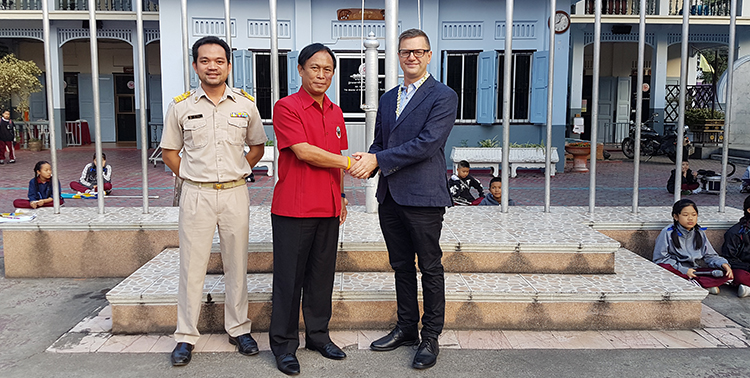
Sharing Literacy Resources
From the morning of day 1, Poom and I began team-teaching literacy activities that we designed for our own classrooms and that we can now share across the two schools. What a rewarding experience! Poom created a template for a neat folded ‘bilateral booklet’. Students drew the Thai and Australian flags/ animals/ foods and labelled them in English. This simple activity provided so many opportunities for discussion and facilitating the vocabulary and understandings of the junior classes, as well as a great way to get me involved in the lessons as a live English-language resource. Later we shared the Round and Round My Town literacy resource with older students. This resource was developed by Marrickville PS teacher Jeff Crawley. It is a simple template to facilitate students to tell digital stories about their town or school in a multimodel format using the five senses. I was able to share examples created by my 2018 class using their own photographs and descriptive writing. The Thai students worked in a written template that I modified to account for the differences in access to computers and cameras in class and home. This allowed them to draw the pictures and write words and phrases in English. I used their work as a guide to take photos all around Chiang Mai during my visit and then created a digital story for each of the classes I worked with. These will form the basis of my next BRIDGE Partnership presentation to staff, students and parents at MPS.
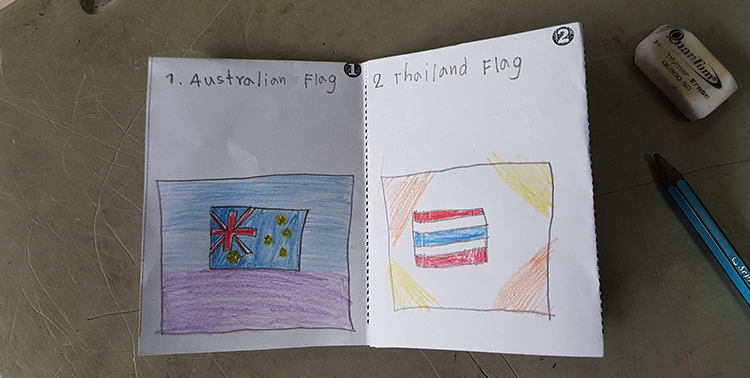
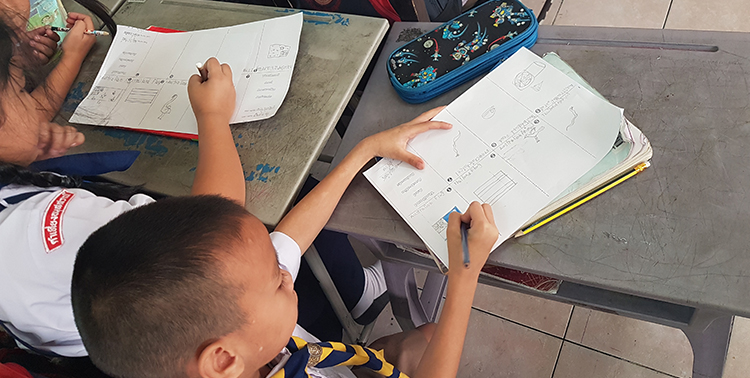
Images: Bilateral booklets/ Round and Round Activity
LINE and the other teachers
Poom introduced me to a range of teachers from across the school including other English language staff, classroom teachers, specialist teachers, executives, and of course Director Kowit. What became immediately clear was that involving other staff would depend on both their level of English language proficiency and their confidence to communicate. Most of the staff had some level of English language proficiency but most relied on Poom as a translator during discussions. Also, my Thai language proficiency is definitely a work in progress! As the visit progressed I was delighted that our call out to the KT Anussorn staff to join the LINE discussion group with Marrickville PS staff resulted in two of the English language teachers accepting the invitation. We welcomed May, a year 4 teacher, and Ruansai, one of the deputy directors, to our group, and I hope we can continue to build our partnership with them.
IT
One of the key elements of the reciprocal visit was gaining a first-hand understanding of the technologies available in the Thai classroom to support our collaborations. While there are significant differences in the access to technology, we were able to explore and plan technology practices which we will be able to use to further the communication and sharing between our schools. Poom and I trialled using Google Hangouts to video chat, and are now confident of using this technology to begin dialogues between classes in our schools. We used the TV screens in available in each classroom to show digital stories and short films created by Marrickville PS students. We also shared these resources, the lessons, student experiences and a whole range of other educational practices including music, art and whole school experiences with staff in Australia via our LINE discussion group, and participants across the region through the WhatsApp discussion forum.
Problem Solving
Ongoing review and problem-solving is a crucial part of the partnership. While setting creative and ambitious goals is a positive reflection on the vision of the school partners, a healthy dose of pragmatism is equally as important for recognising the difference between the imaginable and the achievable. We both still face the issue of motivating our colleagues to participate in aspects of the partnership. The English language level of the KT Anussorn students which means most of the younger ones are not able to engage in facetime discussions and need support to read and write simple English. The IT lab at Poom’s school is not available to other teachers and the teacher in charge doesn’t speak English, so we are restricted in the way KT Anussorn students can use computers at school. These are some of the problems affecting activities we planned in 2018. We will be focusing on some of the activities which make use of other aspects of our partnership while seeking ways to support teachers and students to engage with communicative literacy activities. The simple act of sharing is the basis of our partnership and building on this foundation is the way forward.
Educational Context
One of the deeply engaging experiences of the reciprocal visit the amount of curriculum and educational practice that Poom and I shared. In addition to the co-planning, development and team-teaching of intercultural literacy resources we discussed at length the educational aspects of the resulting teaching and learning. I also spent a significant part of my visit in discussions with my host partner and the other Thai teachers I met discussing their educational context. Classroom requirements, school structure and leadership, a whole range of protocols from playground to privacy to photographic permissions, national testing, parental expectations and pressure, resourcing, behaviour management and of course politics. This immersion experience was crucial for understanding the possibilities and challenges in our partner schools, and across the whole context of intercultural partnerships.
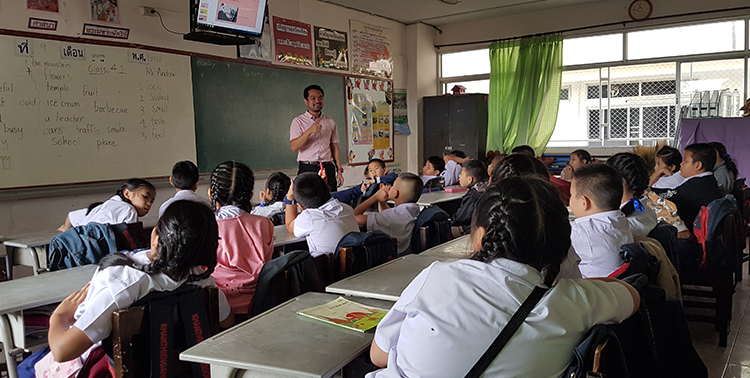
Image: Classroom team-teaching
Other Opportunities for our Partnership
Every morning The KT Anussorn School band finish their daily practice and set up for the whole school assembly. They practice every morning and afternoon, as well as most weekends. Much of their practice is self-directed with the senior students taking charge. I was told that instrumental music is a pathway to placement in valued high schools, so students and their families are highly motivated to succeed in this area. The band program represents a great opportunity for connections between our two schools, as we have an extensive instrumental music program from K-6. During my visit, I shared photos, videos and discussion of the KT Anussorn music program with music-focused teachers from Marrickville PS. One of our teachers arranged the KT Anussorn school march for our Recorder Ensemble, recorded it as a multi-instrumental track and sent it back for me to share with the school. The next morning I arrived at school to hear this track being broadcast over the school PA system. The connections are already happening! I also really enjoyed the opportunity to sit in with Teacher Pope and his students in a music class.
Visual Arts teach Narin is a very well-known and accomplished artist in his own right. In fact he will soon travel to Los Angeles for an exhibition of his works. His classroom is adorned with student works alongside works of his. I am very interested in this approach to normalising the creative efforts of teachers alongside the efforts of their students. At Marrickville PS, one of our staff has written songs for the school choir and whole school to sing. A direct result of this has been students feeling empowered to write and perform their own songs at a range of school events. In 2017, the school choir performed one of the teacher’s songs side-by-side with one of the student’s compositions. We have a newly appointed leader of visual arts at Marrickville PS who is enthusiastic about the possibilities of collaboration with the KT Anussorn students and art teacher. I also sat in on an Art class with Narin, met his family and visited his home for dinner. I am very thankful to both Narin and Pope for sharing their teaching and learning, their hospitality, and their enthusiasm for partnership opportunities.
Children’s Day
Children’s Day is a national celebration across Thailand. Schools, temples, towns, villages, marketplaces are transformed into festivals of song, dance, dress-ups, games, all-day lotteries where every child wins a prize and the lucky few win a bike, oh…and sugar…so much sugar! At KT Anussorn School every class dressed up and performed, starting with a group of girls singing and dancing in beautiful traditional outfits. The fairy floss arrived by 9am and there was no turning back. A party atmosphere filled the air and the dancing was high energy with teachers taking turns at DJing and drawing lottery prizes. Late in the day the bike winners rode round the playground followed by clouds of hangers-on, and sugar-overloaded children handed me packets of biscuits, chips and lollies while rolling their eyes and declaring “im!!” (full!!).
Sightseeing
A key element of the reciprocal visit is spending social time with the host teacher, and Poom really was an excellent host. The weekend was spent sightseeing around the mountain which overlooks Chiang Mai. Beautiful temples and spectacular scenery, traditional Hmong villages and the Royal Family’s Summer Palace.
Reciprocal visit effects
This immersion experience was crucial for understanding the possibilities and challenges in our partner schools. The whole experience will provide the springboard for me to create professional learning and resources for my K-6 staff to engage with Asia literacy at a deeper level in their teaching and learning programs. I feel that my capacity to lead in this area has been greatly increased and I am inspired to bring my school on this journey.
Embassy Briefing and Visiting Ban Pheang
During this trip I also had a highly productive briefing at the Australian Embassy in Bangkok with two of the other Thai partnership teachers, Tew and Stewart. This meeting provided an in-depth look at the wide range of education links between our two countries.
After my ten days in Chiang Mai with Poom, I flew to Ban Pheang (far North East Thailand) where I visited one of the other Thai partner schools and was hosted by partner teacher Goi. This visit enabled me to gain further perspective on the Thai education system and experience the similarities and differences between two Thai schools. Ban Pheang is also a beautiful town beside the Mekong River where
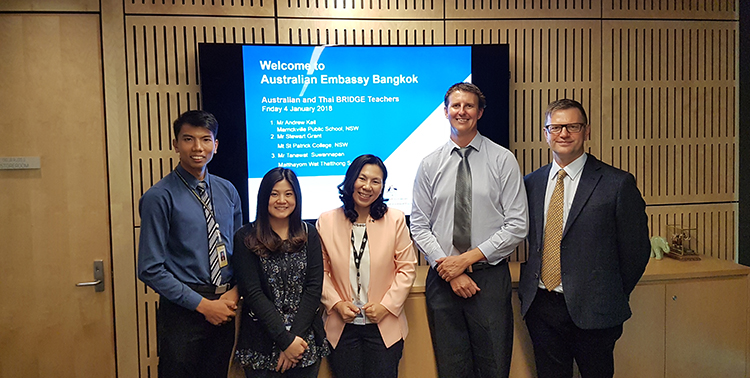
Image: Embassy Briefing
While I already had a good understanding of Thai culture and language, the reciprocal visit provided invaluable insights into the education system, pedagogies, and teaching culture. It also broadened my appreciation of the differences in culture, language, food, lifestyle across different geographies of Thailand.
Through the ASEAN BRIDGE Program I have greatly enjoyed working with other teachers who share the deep sense of moral obligation towards their students to ensure they develop relevant global literacy and capabilities such as the confidence and readiness to interact with diverse peoples and cultures.
Comment